|
|
|
The Land and Its People
|
Individual Life Cycles
A Thai baby officially becomes
"someone" after its name is chosen.
frequently by the abbot of the village
temple, and entered in die village head's
records. Soon after birth the child will
be given a nickname, nearly always of
one syllable. Intimates will continue to
call him or her by this nickname for the
rest of his life and may indeed have to
think for a while to remember the proper name.
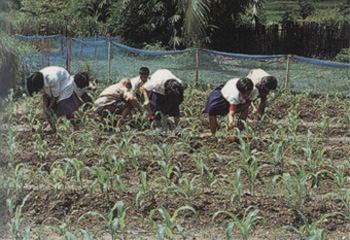
School children are taught to practice planting in their schools |
Childhood is a carefree, cossetted
time. By the age of four children
regularly meet up to play beyond the
family compound, with boys and girls
generally segregated and roaming freely
throughout the village. Boys play
make-believe games, fly kites, plough
imaginary fields, and hunt insects and
harmless reptiles. Girls nurse make-shift
dolls, "sell" mud-pies in make-believe
markets, play games emulating their
mothers, and look after younger
brothers and sisters.
Gradually the children are drawn
into work patterns. At around eight years
of age, girls increasingly help with
household chores and boys assume
greater responsibilies such as feeding
domestic animals and guarding the
family buffalo as it grazes or wallows in mud-holes.
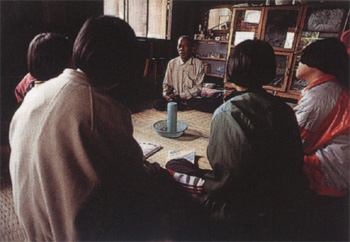
Childhood is a carefree time |
Children also attend the government
village school to be taught from a standard
nationwide curriculum. They acquire
varying degrees of literacy and study
Buddhist ethics and Thai history. All receive a comprehensive education and by
coming into contact with children from
neighbouring villages and visiting the
provincial capital on school trips they
enjoy a broadening of social experience.
Having received ever-increasing
workloads and responsibilities, youths
of 15 or 16 are already regarded as
fully mature adult labourers. Between
graduation from school and marriage at
around 20, most village males go into
the monastery, usually for the duration
of one rainy season, to make merit for
themselves and their parents; in some
areas, a man who has never been a monk
is avoided by marriageable girls, who
regard him as a khon dip, literally an '"unripe person."
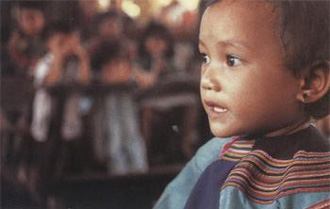
Childhood is a carefree time |
The village girl's entrance into
adolescence is a gentle one. Courtship
is confined initially to communal work
groups during planting and harvesting
and at monastery-centred feslivals
and activities. There may be extensive
banter between boys and girls but,
individually, young people tend to be
shy and "whirlwind courtships" are
exceedingly rare, Emotional relationships
mature slowly and customarily involve
chaperoned meetings at the girl's house.
Most young people select their
own marriage partners. Parental
disapproval is rare since marriages
often take place between families within
the same village, further strengthening
and widening communal ties, A marriage is sometimes presented as a fail
accompli by children who work in towns
or cities beyond parental control. In
many parts of the country, it is the
custom for the groom to move in with
the bride's family, thus providing extra
labour for the family fields and also,
incidentally, avoiding friction between
mother and dauehter-in-law.
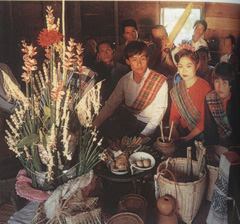
Marriages often take place within the same village |
Early in the morning of the wedding
day, in accordance with traditional
Buddhist belief that married life should
begin with merit-making, the bride and
groom feed village monks and present
them with small gifts. In return, the
monks bless the couple and the house
or room where they will live.
This village marriage ceremony
bestows no official validily on their
union but is merely a public proclamation that the two people will live together
as man and wife. The young couple's
wrists are ceremoniously bound together
in the presence of village elders and they
are led to their marriage chamber as
guests feast, drink, sing, and dance.
Later. their marriage is officially registered at the district office and becomes
a fact of law. Daily tasks are generally
divided equally between husband and
wife. Women normally do the household
chores, but they work in the fields
during planting and harvesting. Men
perform heavier tasks and fieldwork.
fetch water, and occasionally clean their
own clothes. Thai village men are often
very good cooks and sometimes help
prepare the food for festivals.
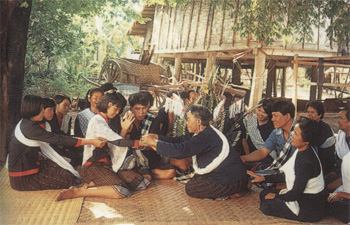
Ceremonial binding of a couples's wrist |
After marriage, every couple
eagerly awaits the birth of their first
child, which usually comes during the
first year. Children have a high position
in rural values since there is strength
in numbers, a vital sense of continuity
is ensured, and many hands make
farming activities easier. Often there is
an unspoken preference for boys since
they alone may he ordained as priests to
gain merit for themselves and their
parents, but no love is withheld if the
child proves lobe a girl.
Everyday village dress is simple,
Men generally wear shorts, a plain shirt.
and their versatile phakaoma, a checkered rectangle of cloth
loosely worn around the waist which, at a
moment's notice, can serve as a turban for
protection against the sun, a loincloth
for modesty during public bathing, a
sweat-absorbing towel, or a hammock.
Women wear the phasin, the Thai
version of the sarong, and a simple
blouse or bodice. Children wear similar
clothing as their parents except when
they are dressed in their school uniforms.
| | |
|
|